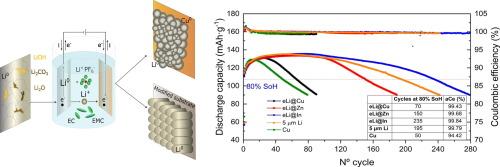为高质量和性能的薄电沉积锂金属阳极定制铜界面
IF 8.9
2区 工程技术
Q1 ENERGY & FUELS
引用次数: 0
摘要
锂金属阳极(LMA)由于其高理论容量(3860 mAh g - 1)和低电化学电位(与标准氢电极相比为- 3.04 V)而被认为是下一代高能量密度电池的关键组件。在充分利用其潜力的策略中,实施低锂过剩尤其有希望,以更低的成本实现具有竞争力的实用能量密度值。然而,由于与电池性能相关的性能挑战以及传统锂生产工艺的局限性,LMAs的广泛采用仍然受到限制。本研究探索电沉积作为一种可行的方法来制造薄LMAs。特别是,通过磁控溅射对衬底改性的影响进行了系统的研究,表明溅射金属和锂之间的相互作用直接影响电沉积锂的形貌和表面组成,并最终影响电池的电化学性能。这项工作强调了电沉积作为一种有前途的替代工艺,可以生产适合高能量密度锂金属电池的高质量和薄的LMAs。本文章由计算机程序翻译,如有差异,请以英文原文为准。

Tailoring copper interfaces for high quality and performance thin electrodeposited lithium metal anodes
Lithium metal anode (LMA) is considered a key component for next-generation high-energy-density batteries due to its high theoretical capacity (3860 mAh g−1) and low electrochemical potential (−3.04 V vs. standard hydrogen electrode). Among the strategies to harness its full potential, implementing low lithium excess is particularly promising, enabling competitive practical energy density values at lower cost. However, the widespread adoption of LMAs remains limited due to performance challenges associated with cell performance and limitations in conventional lithium production processes. This study explores electrodeposition as a viable approach to fabricate thin LMAs. Particularly, the effect of substrate modifications via magnetron sputtering is systematically investigated, demonstrating that the interaction between the sputtered metal and lithium directly influences the morphology and surface composition of the electrodeposited lithium, and, ultimately, the electrochemical performance of the cell. This work highlights electrodeposition as a promising alternative process for producing high-quality and thin LMAs suitable for high energy density lithium metal batteries.
求助全文
通过发布文献求助,成功后即可免费获取论文全文。
去求助
来源期刊

Journal of energy storage
Energy-Renewable Energy, Sustainability and the Environment
CiteScore
11.80
自引率
24.50%
发文量
2262
审稿时长
69 days
期刊介绍:
Journal of energy storage focusses on all aspects of energy storage, in particular systems integration, electric grid integration, modelling and analysis, novel energy storage technologies, sizing and management strategies, business models for operation of storage systems and energy storage developments worldwide.
 求助内容:
求助内容: 应助结果提醒方式:
应助结果提醒方式:


